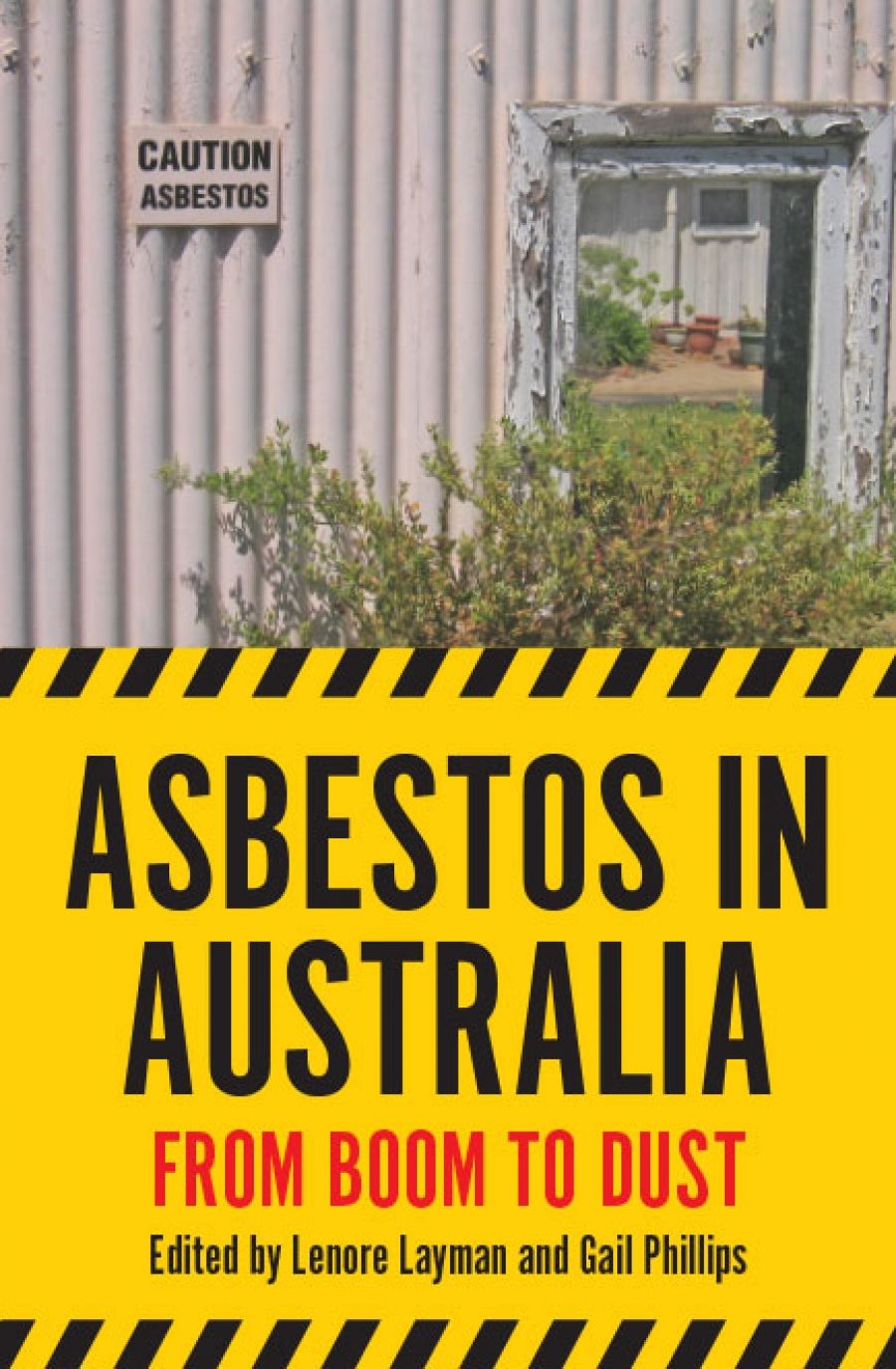
- Free Article: No
- Contents Category: Environmental Studies
- Review Article: Yes
- Grid Image (300px * 250px):

- Alt Tag (Grid Image): Asbestos In Australia
- Book 1 Title: Asbestos in Australia
- Book 1 Subtitle: From boom to dust
- Book 1 Biblio: Monash University Publishing, $39.95 pb, 364 pp, 9781925835618
It took another decade before the full extent of the disaster became apparent. In the early 1960s, South African doctors observed the appearance among asbestos miners of mesothelioma, an incurable form of lung cancer. Australian cases soon appeared, but because of its long latency period, the incidence of the disease among workers and their families at Wittenoom, and in the factories of the biggest asbestos manufacturer James Hardie, was not evident until the 1970s. The epidemic peaked in 2017, but it is not over yet: people will be dying from mesthelioma for another twenty-five years.
The full cost of Australia’s fatal affair with asbestos may never be known, but Asbestos in Australia: From boom to dust, based on a National Health and Medical Research Council interdisciplinary research project, is the most complete reckoning so far. Historian Lenore Layman has followed the story since the early 1980s. With doctors, epidemiologists, lawyers, journalists, and unionists, she played a part in the campaign to expose the problem and bring redress to the victims. In three deeply researched and reflective opening chapters, comprising almost a third of the book, she reviews the development of the industry, its impact on the built environment, and the response of public-health experts to the crisis. Later chapters by journalists, medicos, and lawyers survey professional responses. Former residents contribute moving firsthand accounts of living in Wittenoom and at Baryulgil near Grafton, where Aboriginal people were employed in a smaller white-asbestos mine run by Wunderlich and James Hardie. There is some inevitable untidiness and repetition in a book that attempts to combine so many personal and disciplinary viewpoints. Not all readers will make their way through the denser technical chapters. But as a comprehensive account of the disaster ,it is unlikely to be bettered.
 Blue asbestos mineral (crocidolite) from the now closed mine at Wittenoom, Western Australia (photograph by John Hayman/Wikimedia Commons)
Blue asbestos mineral (crocidolite) from the now closed mine at Wittenoom, Western Australia (photograph by John Hayman/Wikimedia Commons)
Layman narrates the story as a modern tragedy, a fatal compound of hubris, ignorance, complacency, and greed. In the early postwar years, she reminds us, asbestos was hailed as a ‘magic mineral’: durable, malleable, and impervious to fire and heat. Cheaper than brick or weatherboard, asbestos cement sheeting (‘fibro’) clad thousands of Australian homes, especially in the working-class suburbs of Sydney and Perth. Future prime minister Paul Keating grew up in a fibro cottage in Bankstown. My father, a plumber installing hot-water services and bathrooms in spec-built cottages in postwar Melbourne, regularly sawed, drilled, and nailed the stuff. The magic mineral was the poor man’s friend: a source of well-paid dangerous jobs and cheap housing. As Layman notes, fibro always carried the stigma of social disadvantage. Now those workingmen’s cottages are shunned as death traps.
Gideon Haigh, historian of James Hardie Industries, notes the emblematic significance of the asbestos story for a nation ‘struggling to come to terms with aspects of its past and wondering whether it should have known more at various stages in its history’. As we grapple with other bitter legacies – of Indigenous dispossession, clerical abuse, financial malfeasance, and environmental neglect – we may find ourselves asking similar questions: When did they know? Why did they ignore the truth-tellers? Was the blindness innocent or wilful?
In 1948, when Eric Saint sounded the alarm, even he did not comprehend the extent of the danger. McNulty still worries that he did not protest loudly enough. Looking back, the errors of the past seem blindingly obvious – perhaps too obvious. The forensic gaze of the doctor seeking causes or the lawyer seeking redress too easily misses the all-too-human frailties that appear in a more comprehensive study such as this.
Along with greed and culpable carelessness, there were large elements of ignorance, inexperience, inattention, and the most besetting of Australian sins – blind faith that ‘she’ll be right’. CSR, the sugar company that ran the Wittenoom mine, blundered into a business it only half understood. James Hardie, the old-fashioned company that ran the factory, could not believe that it was actually doing harm it did not intend. Health Department officials in Perth were too far away to care enough about what was happening at the other end of the state. Old hands in the mining business thought they knew better than a couple of young know-it-all Pommy doctors. Workers, as well as employers and unions, were so intent on making a quid that they simply didn’t want to know about the dangers.
Of such mixed motives are we humans – and such tragedies – made. The authors point a persuasive lesson: only by strong laws and the mutual watchfulness of everyone – employers, governments, unions, and workers – will they be avoided in future.


Comments powered by CComment